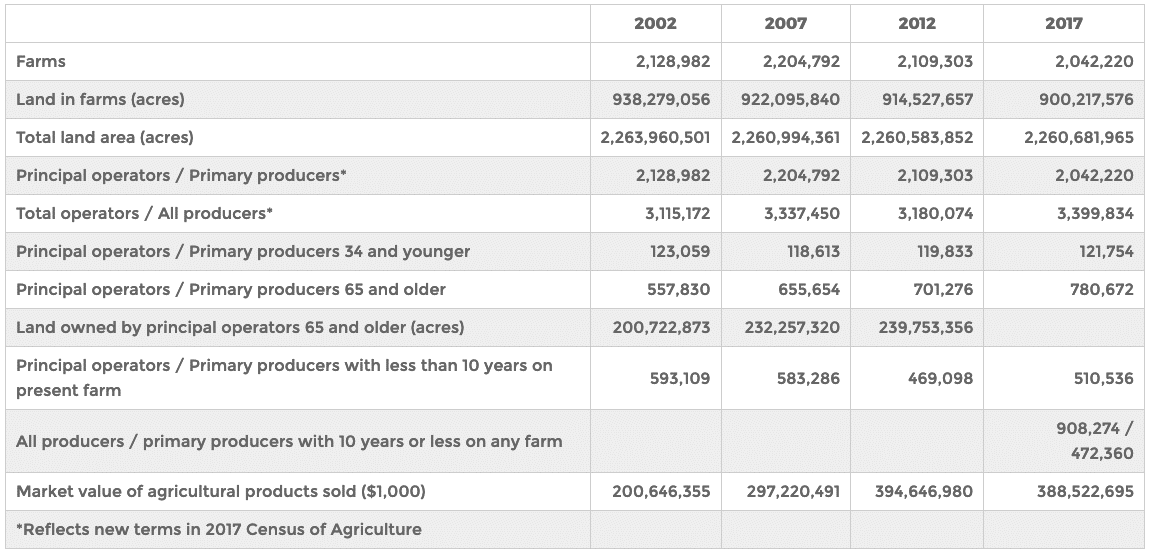In the coming decades, the United States will face a crisis in farmland loss and ownership transfer that will decide the future of our food system and the people and land that support it. Over the past 40 years, 25 million acres of farmland have been permanently lost due to commercial, industrial and residential development. By 2040, an expected 70% of the 911 million acres of farmland in the United States will change hands, as 40% of all current farmland is owned by people aged 65 or older. (Of that 911 million acres, 98% is owned by white individuals).
Not Every Farmer Wants to “Get Big or Get Out”
As land ownership continues to consolidate into fewer and wealthier hands, some small farmers vow to stay in place


Compounded with the devastating effects of climate change, such as accelerating sea level rise and drought, this massive transfer of land and wealth threatens global food security, local food systems and ecosystems that depend on the health of the land.
In the following excerpt from the new book Love for the Land: Lessons from Farmers Who Persist in Place, published this week by Yale University Press, Brooks Lamb, farmer, author and Land Protection and Access Specialist at American Farmland Trust reckons with the implications of this large-scale transfer through the lens of Robertson County, Tennessee. Located sixty miles north of the author’s place of birth, the county is experiencing the highest rate of farmland loss in Tennessee. Through a series of intimate portraits and cogent analysis, Love for the Land confronts the hard realities and structural injustices facing young farmers and farmers from marginalized backgrounds and how these farmers are cultivating resilient communities and regenerating the health of our land.
I pulled into a pasture-turned-parking-lot and stepped out of my truck. After putting on a face mask and sanitizing my hands—the protocol for in-person research during the early days of the pandemic—I started walking toward a big, white tent in the middle of the field. A few dozen people had already arrived. Some were saving seats for friends or business partners. Some were visiting the concessions trailer to buy a cold drink, already seeking relief from the hot and humid August morning. We were all there for the same reason: to watch a farm sell.
Near the tent, two men—one young, one old—leaned against the tailgate of a blue Silverado. They wore boots, jeans, and ball caps, and they talked to each other quietly as people streamed toward the tent. I nodded hello. They nodded back. “Any chance this land sells as a farm?” I asked. They younger man laughed and shook his head. Developers would buy the land, he said. They would put dozens of houses right where we were standing. “We’ve got a small farm about a mile away,” he said, “and this shit’s happening all around us.” With a shrug and a sigh, he turned back toward his father, and I kept walking.

Not long after I settled into a socially distanced spot outside the tent, the auctioneer began to work. He explained the sale rules and answered questions from the crowd. With a booming drawl, he reiterated what had been advertised on signs across the county: “This land has a ton of development potential, folks. Do not miss this opportunity!”
The sale started, and one by one, five- and ten-acre tracts were sold. People in polos and T-shirts emblazoned with the names of construction companies thew up their hands and nodded their heads. Cries of “Yep!” exploded from the auctioneer’s assistants. A few farmers tried to bid, but the price soon eclipsed what they could offer, even when they teamed up with friends and neighbors. In two hours, 188 acres were sold to the highest bidders at an average of $23,000 an acre. As predicted, developers had prevailed, their ownership soon to be marked with signatures, signs, and scars from dozers. The people selling the property—nonlocal heirs of a deceased farmer—did not attend the auction.
This scene, or variations of it, is playing out all over Robertson County, Tennessee. And it is happening more and more often. Over the past few decades, this one county has lost tens of thousands of acres of farmland. In part due to sprawl coming from the nearby cities of Nashville and Clarksville, both of which are growing at rapid rates, the future of this county’s agricultural land, farmers, and rural communities is uncertain.
While the farmland loss occurring in Robertson County is acute, it’s not isolated. Agricultural landscapes in the United States have been and still are being converted to residential and commercial uses at staggering rates. According to American Farmland Trust’s most recent reports, roughly 11 million acres of agricultural land were converted to nonfarm uses between 2001 and 2016 alone. Due to the Great Recession, development actually slowed for several years during this period. So 11 million acres, or about 2,000 acres per day, were lost despite several years of economic hardship and construction slowdowns. Forward-looking reports from American Farmland Trust suggest that unless we mend our haphazard development ways, millions more agricultural acres will be compromised by 2040. While the most extreme threats to farmland are in the South—Texas, North Carolina, Tennessee, and Georgia are ranked numbers one, two, four, and five, respectively—most every state is affected.[1]

In Robertson County, as well as many other communities across Tennessee, the South, and the nation, it’s not just farmland loss from development that is impacting rural, agricultural communities. Once an area filled with small and midsized farms—farms that I have classified here as roughly 50-499 acres in size, which is a subjective range (and may not be appropriate for communities in other parts of the nation) but uses local context and draws on other descriptions—Robertson County’s remaining farmland is steadily becoming dominated by large-scale agriculture.[2] While many of the country’s biggest operations are technically “family farms” under the broad definition of the US Department of Agriculture (USDA), they encompass thousands of acres, monopolize production, and use practices and methods that are often more industrial than agricultural. These farms are extremely capital-intensive, and they often rely on complex systems of financing and credit, as well as government support, to operate. Small-scale farmers, many of whom also work off-the-farm jobs to make ends meet, struggle to compete. Their existence is threatened.
This combination of agricultural consolidation and rapid farmland loss leaves some locals feeling like they are getting “squeezed out” of farming altogether. For people who hope to continue caring for their farms or start new farms of their own, it tempts despair. I saw this anguish firsthand at the farm auction: in the faces of neighboring farmers who had come to watch, knowing they couldn’t make competitive bids; in a young ring man who worked for the auction company, who told me he hated selling farmland but needed this job to support his own farm.

But I also saw signs of resistance from farmers and farm-service providers, land conservationists and community leaders in Robertson County. In my conversations with these folks, they discussed the challenges that small and midsized farmers face, the changes that have occurred in their communities in recent years, and the future of farming in the county and nation. While they had different perspectives on these issues, most agreed that it is hard for small timers to hang on to farmland in their community. It is not often very profitable, at least in any meaningful way. “The easy way out would have been to quit a long time ago,” one woman told me. Another farmer said, “The hard thing is keeping the land. The easy thing is to sell and be done with it.”
Still, many people I spoke with are making sacrifices—doing what’s hard instead of what’s easy—to continue caring for their farms. Using different words and phrases to describe their reasons for resilience, many unknowingly referenced Wendell Berry’s virtues of imagination, affection, and fidelity as key motivators. “I just love this farm, OK?” one older farmer said. As we sat in his modest living room, just down the hall from the bedroom where he was born, he elaborated on his family’s fidelity to the farm. “If somebody offered me $20,000 an acre, I’d just tell them to go to hell.”
I laughed at that remark, thinking it a joke. He didn’t. It wasn’t.
In Robertson County, some determined farmers, young and old, are refusing to “get big or get out,” as many government officials, extension agents, and business leaders have told them to do. These people are not expanding their farms to outcompete neighbors. They are not selling their land to become the next new subdivision or the latest addition to a ten-thousand-acre operation. Instead, they are continuing to nurture relationships with their land and place, to serve as caretakers, stewards, and “stickers.” In doing so, these farmers practice imagination, affection, and fidelity on the ground.
[1] Baker, Bulldozer Revolutions; Coulthard, “Changing Landscape of America’s Farmland”; Rome, Bulldozer in the Countryside; Thompson and Prokopy, “Tracking Urban Sprawl”; Freedgood et al., Farms under Threat; Hunter et al., Farms under Threat 2040. Although Tennessee was ranked fourth in the nation for farmland loss from 2001 to 2016, the state jumps to third when projecting future farmland loss over the next two decades, just behind Texas and North Carolina. Estimates by Hunter et al. show that under current development trends, Tennessee could sacrifice over a million additional agricultural acres—or more than 8 percent of its total farmland—by 2040 (22).
[2] Establishing parameters for farm size is a difficult task, and people approach it in different ways. Some researchers and officials, for example, use total farm income or sales to assign a size category to farms. But in Family Farming: A New Economic Vision, Marty Strange argues against using this metric to describe farm size, largely because of price discrepancies between years, differences in profit margins between farm type, variations within farm size group, and bunching toward the low end of each classification’s income spectrum (69-71).
Brooks Lamb is the Land Protection and Access Specialist at American Farmland Trust. He is the author of Love for the Land: Lessons from Farmers Who Persist in Place.
Have thoughts or reactions to this or any other piece that you’d like to share? Send us a note with the Letter to the Editor form.
Want to republish this story? Check out our guide.
More from Barn Raiser

A Fighting Faith







